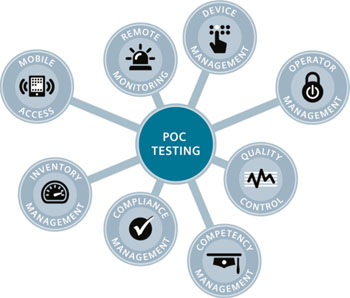Increasing Point-of-Care Testing Workload Addressed with New Integrated Systems Solution
|
By LabMedica International staff writers Posted on 17 Mar 2015 |

Image: The new Ecosystem solution and approach helps tackle data management challenges faced by point-of-care coordinators in the clinical laboratory (Photo courtesy of Siemens Healthcare Diagnostics).

Image: The point-of-care (POC) testing Ecosystem solution and approach encompasses eight core components: device management, operator management, quality control, compliance reporting, competency management, inventory management, remote monitoring, and mobile access (Image courtesy of Siemens Healthcare Diagnostics).
Challenges faced by clinical laboratory point-of-care (POC) coordinators can now be more efficiently tackled with an innovative approach developed as a new component of an informatics solution for managing in vitro diagnostics (IVD) analyzers and operators.
Siemens Healthcare Diagnostics, of Siemens AG (Berlin and Munich, Germany), now offers its new Ecosystem solution, an integrated component of its RAPIDComm Data Management System, an informatics solution that centrally manages Siemens IVD analyzers and operators.
Ecosystem, which encompasses eight core components, includes device management, operator management, quality control, compliance reporting, competency management, inventory management, remote monitoring, and mobile access.
“Siemens Healthcare Diagnostics has been carefully analyzing the POC market and is ready to provide a holistic approach to testing,” said Afia Boamah, product manager of Blood Gas, Stratus CS & POC IT S at Siemens Healthcare Diagnostics, “POC testing continues to grow at a rapid pace and there is a strong need to provide fast and reliable results.” “Although solutions for each of the 8 core components do exist individually, efficiently managing all aspects of a POC testing program requires close collaboration among hospitals, device manufacturers, and IT vendors. The Siemens POC Ecosystem helps to address this challenge by implementing an integrated solution which improves the efficiency and effectiveness of POC programs,” added A. Boamah.
Ecosystem takes the core needs of a POC program into consideration with a focus on helping POC coordinators improve control, effectiveness, and transparency. It manages secure access to POC devices, oversees quality control, manages staff training, and identifies and resolves issues - from any location via the remote access facility. This helps ensure manageability of instruments and consumables for potentially hundreds of testing devices. External compliance requirements are also met, while reducing costs.
“We are working hand-in-hand with healthcare providers to adapt to clinical environments making use of handheld IT devices such as tablets and smart phones. The Ecosystem solution allows POC data management from anywhere within a hospital using these devices, which improves the ability of POC coordinators to quickly and efficiently resolve issues. This has been highlighted by customers as a critical requirement in a fast-paced laboratory environment,” said A. Boamah.
Related Links:
Siemens
Siemens Healthcare
Siemens Healthcare Diagnostics, of Siemens AG (Berlin and Munich, Germany), now offers its new Ecosystem solution, an integrated component of its RAPIDComm Data Management System, an informatics solution that centrally manages Siemens IVD analyzers and operators.
Ecosystem, which encompasses eight core components, includes device management, operator management, quality control, compliance reporting, competency management, inventory management, remote monitoring, and mobile access.
“Siemens Healthcare Diagnostics has been carefully analyzing the POC market and is ready to provide a holistic approach to testing,” said Afia Boamah, product manager of Blood Gas, Stratus CS & POC IT S at Siemens Healthcare Diagnostics, “POC testing continues to grow at a rapid pace and there is a strong need to provide fast and reliable results.” “Although solutions for each of the 8 core components do exist individually, efficiently managing all aspects of a POC testing program requires close collaboration among hospitals, device manufacturers, and IT vendors. The Siemens POC Ecosystem helps to address this challenge by implementing an integrated solution which improves the efficiency and effectiveness of POC programs,” added A. Boamah.
Ecosystem takes the core needs of a POC program into consideration with a focus on helping POC coordinators improve control, effectiveness, and transparency. It manages secure access to POC devices, oversees quality control, manages staff training, and identifies and resolves issues - from any location via the remote access facility. This helps ensure manageability of instruments and consumables for potentially hundreds of testing devices. External compliance requirements are also met, while reducing costs.
“We are working hand-in-hand with healthcare providers to adapt to clinical environments making use of handheld IT devices such as tablets and smart phones. The Ecosystem solution allows POC data management from anywhere within a hospital using these devices, which improves the ability of POC coordinators to quickly and efficiently resolve issues. This has been highlighted by customers as a critical requirement in a fast-paced laboratory environment,” said A. Boamah.
Related Links:
Siemens
Siemens Healthcare
Latest Technology News
- Pioneering Blood Test Detects Lung Cancer Using Infrared Imaging
- AI Predicts Colorectal Cancer Survival Using Clinical and Molecular Features
- Diagnostic Chip Monitors Chemotherapy Effectiveness for Brain Cancer
- Machine Learning Models Diagnose ALS Earlier Through Blood Biomarkers
- Artificial Intelligence Model Could Accelerate Rare Disease Diagnosis
- AI Saliva Sensor Enables Early Detection of Head and Neck Cancer
- AI-Powered Biosensor Technology to Enable Breath Test for Lung Cancer Detection
- AI Model Achieves Breakthrough Accuracy in Ovarian Cancer Detection
- Portable Biosensor Diagnoses Psychiatric Disorders Using Saliva Samples
- Cell-Sorting Device Uses Electromagnetic Levitation to Precisely Direct Cell Movement

- Embedded GPU Platform Enables Rapid Blood Profiling for POC Diagnostics
Channels
Clinical Chemistry
view channel
Blood Test Could Predict and Identify Early Relapses in Myeloma Patients
Multiple myeloma is an incurable cancer of the bone marrow, and while many patients now live for more than a decade after diagnosis, a significant proportion relapse much earlier with poor outcomes.... Read more
Compact Raman Imaging System Detects Subtle Tumor Signals
Accurate cancer diagnosis often depends on labor-intensive tissue staining and expert pathological review, which can delay results and limit access to rapid screening. These conventional methods also make... Read moreMolecular Diagnostics
view channel
At-Home Blood Tests Accurately Detect Key Alzheimer's Biomarkers
Diagnosing Alzheimer’s disease typically relies on brain scans or spinal fluid tests, which are invasive, costly, and difficult to access outside specialist clinics. These barriers have limited large-scale... Read more
Blood Test Combined with MRI Brain Scans Reveals Two Distinct Multiple Sclerosis Types
Multiple sclerosis (MS) affects more than 2.8 million people worldwide, yet predicting how the disease will progress in individual patients remains difficult. Current MS classifications are based on clinical... Read more
Ultra-Sensitive Blood Biomarkers Enable Population-Scale Insights into Alzheimer’s Pathology
Accurately estimating how many people carry Alzheimer’s disease pathology has long been a challenge, as traditional methods rely on small, clinic-based samples rather than the general population.... Read more
Blood Test Could Predict Death Risk in World’s Most Common Inherited Heart Disease
Hypertrophic cardiomyopathy (HCM) is the world’s most common inherited heart condition and affects millions of people globally. While some patients live with few or no symptoms, others develop heart failure,... Read moreHematology
view channel
MRD Tests Could Predict Survival in Leukemia Patients
Acute myeloid leukemia is an aggressive blood cancer that disrupts normal blood cell production and often relapses even after intensive treatment. Clinicians currently lack early, reliable markers to predict... Read more
Platelet Activity Blood Test in Middle Age Could Identify Early Alzheimer’s Risk
Early detection of Alzheimer’s disease remains one of the biggest unmet needs in neurology, particularly because the biological changes underlying the disorder begin decades before memory symptoms appear.... Read more
Microvesicles Measurement Could Detect Vascular Injury in Sickle Cell Disease Patients
Assessing disease severity in sickle cell disease (SCD) remains challenging, especially when trying to predict hemolysis, vascular injury, and risk of complications such as vaso-occlusive crises.... Read more
ADLM’s New Coagulation Testing Guidance to Improve Care for Patients on Blood Thinners
Direct oral anticoagulants (DOACs) are one of the most common types of blood thinners. Patients take them to prevent a host of complications that could arise from blood clotting, including stroke, deep... Read moreImmunology
view channel
Ultrasensitive Liquid Biopsy Demonstrates Efficacy in Predicting Immunotherapy Response
Immunotherapy has transformed cancer treatment, but only a small proportion of patients experience lasting benefit, with response rates often remaining between 10% and 20%. Clinicians currently lack reliable... Read more
Blood Test Could Identify Colon Cancer Patients to Benefit from NSAIDs
Colon cancer remains a major cause of cancer-related illness, with many patients facing relapse even after surgery and chemotherapy. Up to 40% of people with stage III disease experience recurrence, highlighting... Read moreMicrobiology
view channel
New UTI Diagnosis Method Delivers Antibiotic Resistance Results 24 Hours Earlier
Urinary tract infections affect around 152 million people every year, making them one of the most common bacterial infections worldwide. In routine medical practice, diagnosis often relies on rapid urine... Read more
Breakthroughs in Microbial Analysis to Enhance Disease Prediction
Microorganisms shape human health, ecosystems, and the planet’s climate, yet identifying them and understanding how they are related remains a major scientific challenge. Even with modern DNA sequencing,... Read morePathology
view channel
ADLM Updates Expert Guidance on Urine Drug Testing for Patients in Emergency Departments
Urine drug testing plays a critical role in the emergency department, particularly for patients presenting with suspected overdose or altered mental status. Accurate and timely results can directly influence... Read more
New Age-Based Blood Test Thresholds to Catch Ovarian Cancer Earlier
Ovarian cancer affects around one in 50 women during their lifetime, with roughly 7,000 diagnoses each year in the UK. The disease is often detected late because symptoms such as bloating, abdominal pain,... Read moreIndustry
view channel
BD and Penn Institute Collaborate to Advance Immunotherapy through Flow Cytometry
BD (Becton, Dickinson and Company, Franklin Lakes, NJ, USA) has entered into a strategic collaboration with the Institute for Immunology and Immune Health (I3H, Philadelphia, PA, USA) at the University... Read more



















